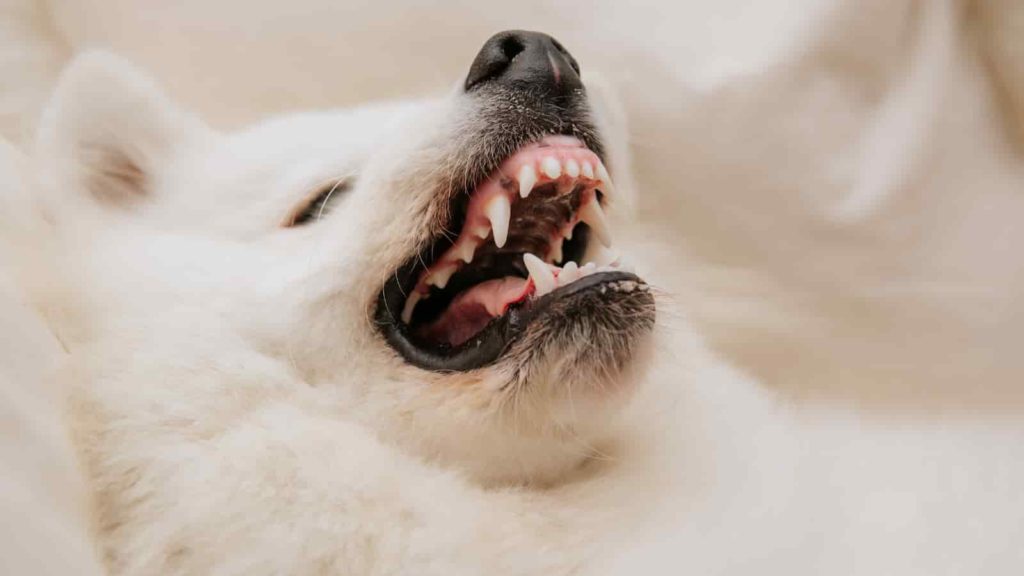While watching tv one night I was stunned when I heard this high-pitched throaty howl. Something I had never heard before. I was stunned and not sure what it was when I realized it was my neighbors Samoyed!
Samoyed dogs are known to be vocal dogs and they may howl or make other vocalizations, such as barking or whining, to communicate their needs or emotions. Samoyed dogs are generally not known to be excessive barkers, but they may bark to alert their owners of something, or to express excitement or frustration.
Disclaimer: This post may contain affiliate links. We only recommend high-quality products that are used and recommended by real owners. If you use these links to buy something we earn a small commission.

Howling can sometimes sound eerie or mournful, especially if it is done in a quiet or isolated location. However, it can also sound joyful or playful, especially if it is done in response to something the dog is excited about, such as playing, greeting its owner, or going on a walk.
What ever it is learning to understand how your Sammy communicates with you will help you build a stronger bond with your dog.
Why Samoyeds Howl
- To communicate over long distances: Howling is a natural behavior that has been observed in wolves and other wild dogs, and it is thought to have evolved as a way for them to communicate over long distances, especially in environments with limited visibility or loud noises.
- To coordinate hunting or defend territory: Howling may also have served as a way for wolves and other wild dogs to coordinate hunting or defend their territory. By howling, dogs may be able to alert other members of their pack to the presence of prey or danger, or to signal their location and intentions.
- To respond to sounds: Dogs may howl in response to a variety of sounds, such as sirens, music, or other dogs howling. Some dogs may be more sensitive to certain sounds than others, and they may howl as a way to express their curiosity or discomfort.
- To express loneliness or boredom: If a dog is left alone for long periods of time or is not getting enough mental or physical stimulation, it may howl as a way to express its loneliness or boredom.
- To express anxiety or distress: Dogs may howl if they are feeling anxious, stressed, or distressed. This may be due to separation anxiety, fear of loud noises, or other sources of stress.
- To express frustration or arousal: Dogs may howl if they are feeling frustrated or aroused, such as when they are trying to get attention, play, or get food.
- To express pain or discomfort: Dogs may howl if they are in pain or discomfort, such as if they have an injury, illness, or infection.
- To express hunger or thirst: Dogs may howl if they are hungry or thirsty, especially if they are used to being fed or watered at certain times of the day.
- To express joy or excitement: Dogs may howl when they are feeling happy or excited, such as when they are playing, greeting their owners, or going on a walk or car ride.
- To express fear or uncertainty: Dogs may howl if they are feeling afraid or uncertain, such as if they are in a new or unfamiliar environment, or if they are confronted with something that scares them.

The evolution of howling
Howling is a natural behavior that has been observed in dogs and wolves for thousands of years. It is thought to have evolved as a way for these animals to communicate over long distances, especially in environments with limited visibility or loud noises.
Howling is a unique form of vocalization that allows dogs and wolves to transmit their location and intentions over a wide area, and to alert other members of their pack to the presence of prey or danger. In addition to its role in communication, howling may also have served as a way for wolves and other wild dogs to coordinate hunting or defend their territory.
Despite its ancient origins, howling remains an important part of the behavior and social dynamics of dogs and wolves today, and it continues to fascinate and mystify humans.
How Samoyeds Howl
Samoyed dogs, like other breeds of dogs, howl by making a long, sustained vocalization that can be high-pitched or low-pitched, depending on the individual dog.
Samoyed dogs are known for their distinctive howls, which may be louder and more distinctive than those of other breeds. To howl, a Samoyed will open its mouth and let out a sustained, wailing sound that may be modulated or varied in pitch. Samoyed dogs may howl continuously, or they may howl in short bursts or in response to specific stimuli.
Samoyed dogs may also howl with their head raised and their mouth open, or they may howl with their head down and their mouth closed. Howling may be triggered by a variety of stimuli, such as sounds, sights, or feelings, and it may serve different functions depending on the context and the dog’s motivations.
How to Manage Samoyed Howling
Here are a few creative ways to get your Sammy dog to stop howling:
- Provide plenty of exercise and mental stimulation:
Howling can sometimes be a sign of boredom or a lack of activity. To help reduce howling, make sure your dog is getting enough exercise, such as walks, runs, or playtime. You can also provide your dog with interactive toys, puzzles, or other forms of mental stimulation to keep it engaged and satisfied. - Establish clear boundaries and rules: Howling can sometimes be a sign of a lack of boundaries or discipline. To help reduce howling, it is important to establish clear rules and boundaries for your dog and to enforce them consistently. This may include training your dog to respond to commands, such as “quiet” or “enough.”
- Ignore the howling: If your dog is howling for attention or to get a reaction from you, it may be helpful to ignore the behavior. This means not reacting to the howling with attention, punishment, or other forms of reinforcement. By ignoring the howling, you can help to reduce the dog’s motivation to do it.
- Use positive reinforcement: Instead of punishing your dog for howling, you can try rewarding it for quiet behavior. For example, you can give your dog a treat or praise when it is quiet and calm, and ignore or redirect it when it starts howling. Over time, this can help to reinforce quiet behavior and reduce howling.
- Consult with a professional: If your Samoyeds howling is excessive or disruptive, or if you have tried other methods and they have not worked, it may be helpful to consult with a veterinarian or a professional dog trainer for guidance and support. They can help you identify the cause of the howling and develop a customized plan to manage the behavior.
Managing a dog’s howling behavior is possible with the right care, training, and attention. By understanding the causes of howling and implementing effective strategies to address it, you can help your dog be a happy and well-behaved companion. Howling is a natural behavior in dogs, and with the right support, you can help your dog express itself in a healthy and appropriate way.
While we strive to give the most accurate and helpful information about your pet’s health that we can, this article is meant to be informational only and not medical advice. Never disregard, avoid or delay in obtaining medical advice from your veterinarian or other qualified veterinary health care provider regardless of what you have read on this site or elsewhere.



